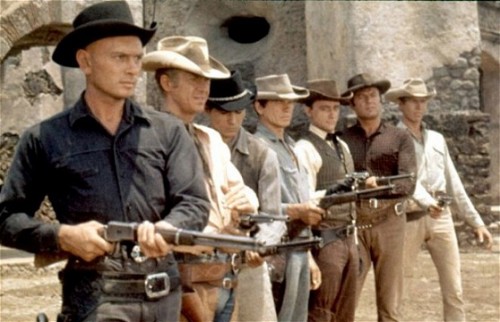
Neatorama presents a guest post from actor, comedian, and voiceover artist Eddie Deezen. Visit Eddie at his website.
Hollywood movies are famous (often notoriously so) for embellishing the truth. This is, of course, a polite way of saying filmmakers often lie. In the interest of entertainment, it seems justified. A down-and-out (but good-looking) young guy without a nickel meets a gorgeous girl, who falls for him, and despite all the warnings and their parents being against it and ...well, you know what I mean. It's fiction, it's fluff. And that's basically what movies do for us; they carry us out of our own mundane, unglamorous lives and into the land of make-believe. And that is fine. But there's another kind of cinematic embellishment. This is the distortion of actual events, real-life occurrences being changed and modified for the sake of "entertainment." This brings us to the foremost example of this second distortion: the "Old West gunfight."
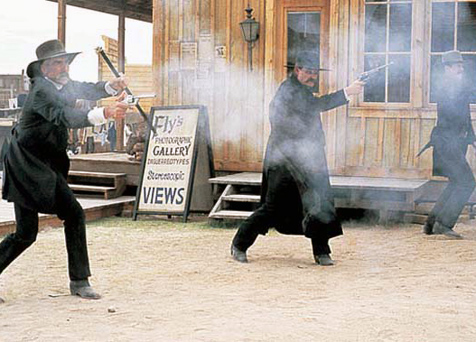
First off, it's not all the fault of Hollywood and the movies. Many years before cinema was even invented, dime novels were printed up, enthralling their eager and avid readers. These pulp novels were extremely popular and carried the written accounts of legendary Old West gunslingers Wyatt Earp, Doc Holliday, Wild Bill Hickok, Buffalo Bill, Bat Masterson, etc. The authors would simply dream up fictional accounts of the exploits of these famed heroes and embellish things that actually did occur. It wasn't only the authors doing this embellishing, as many of the actual participants themselves would "color" their own stories for the sake of a good story. Newspapers, too, would dress up the tales of Old West gunmen in order to boost sales (no kidding? A newspaper not telling the truth? Gee, I'm mortified at that one!).
The fact is, Old West gunfights were few and far between. In popular Western television shows like Bonanza, The Big Valley, Have, Will Travel, and Rawhide, the gunfight is a routine event, taking place about as often as we currently witness a politician being dishonest or your luggage being late coming on the carousel when you arrive at the airport. In some seasons of the longest-running Western TV series ever, Gunsmoke (1955-1975), a formal Hollywood gunfight takes place during the show's opening credits.
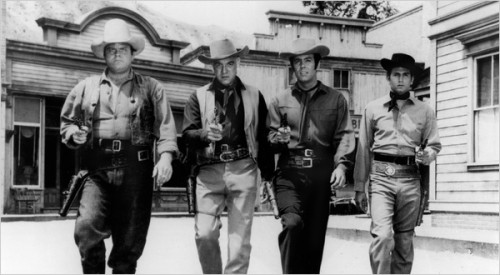
The typical Hollywood gunfight, in TV or in the movies, is two cowboys meeting on the street, usually about ten, twenty, or maybe twenty-five feet apart. They formally wait for one of the two to take a first shot. This signals that the fight is on, and gives the second cowboy (almost inevitably the hero, the lead, the "good guy") the right to then draw. This second guy, also almost inevitably, wins the fight. Actual facts (I know, this is a redundancy, but I wanted stress) about the Old West are tough to pin down. The following facts do appear to be true. Actual gunfights in the Old West were very rare, very few and far between. When they did occur, not one, but several gunshots were usually fired. Often onlookers were hit. And also, no one knew who actually won the fight until several minutes after the gunshots, as it took a while for all the gun smoke to clear in the air.
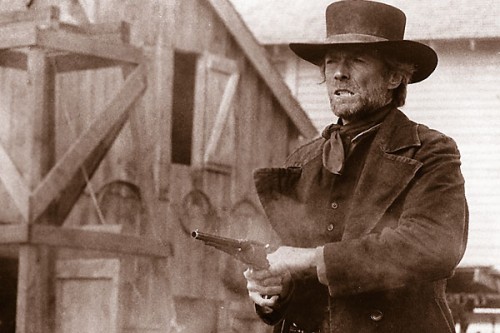
And unlike in the movies, easy shots were often missed. Often the two just continued firing until they had completely emptied their pistols. Most experts on the Old West also agree, it was not the "fastest gun" who won. Most gunfights went to the more accurate shot. But even above speed and accuracy, a "cool head" took precedence and was the single most valuable asset for a gunman. Although many Old West legends have "fast gun" reputations, it appears that John Wesley Hardin, Wild Bill Hickok, Doc Holliday, and Billy the Kid were actually really fast guns. But even famous "quick draws" didn't go the formal route in their gunfights. Why? It was still too risky for a "fast draw" or a "good guy" to lose. Much more frequently than the typical Hollywood face-to-face draw, a cowboy would gun a guy down at the most opportune point. Meaning, if he got a drop on his enemy, if he was unarmed, or even if it meant shooting him in the back.
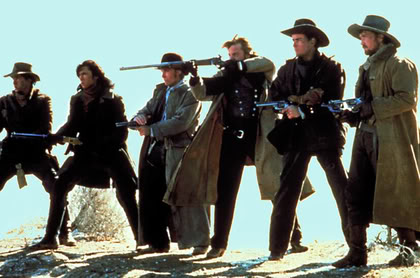
The typical Hollywood gunfight distance too, was often varied. Sometimes two opposing gunmen would be very close and would circle each other, like caged animals, before opening fire on each other. In 1865, in one of the few actual documented gunfights (with evidence and valid testimony), James Butler Hickok ("Wild Bill" Hickok) had a bad quarrel with Davis Tutt in Springfield, Missouri. The fight was over a debt. At around 6PM, the two advanced on each other in the town square. The men drew guns at a distance of around 50 yards and blasted away. Tutt missed. Wild Bill didn't. Tutt fell with a bullet through his heart. Hickok was tried for manslaughter and acquitted. A sensational account of the gunfight appeared in Harper's magazine in 1867. This account made Hickok a national celebrity. This fairly "Hollywood" gunfight, although it did occur, was a rarity. The 50 yard distance was questioned by skeptics, but was verified by several onlookers.
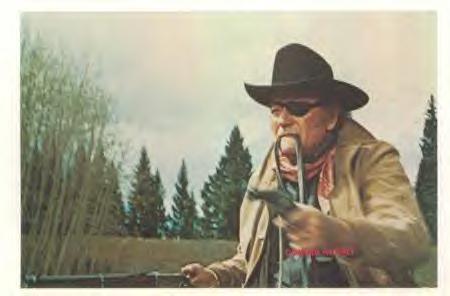
Another "mistake" Hollywood makes about gunfights is the "gun in the holster" myth. True, gunfights were sometimes conducted with the opponents' guns in their respective holsters, but often the guns were held in belts or in their pockets, and sometimes just tucked into the front of their pants. It was rare, but sometimes the two duelists would just stand up and face each other, each man clutching his gun in hand, no holster draw, no nothing. Oh, and there is one gunfight factor Hollywood did get right: "liquid courage." A great number of Old West gunfights were not the result of some noble cause, like "defending a woman's honor" or some such deal. The consumption of whiskey, liquor, and booze had a hand in a great percentage of mano et mano confrontations in the town square. Still, despite knowledge of the truth. most of us enjoy a good TV or movie gunfight. They're dramatic, they're romantic, they're exciting, and I guess we like them because almost inevitably the good guy wins. And this isn't always so in real life, is it?
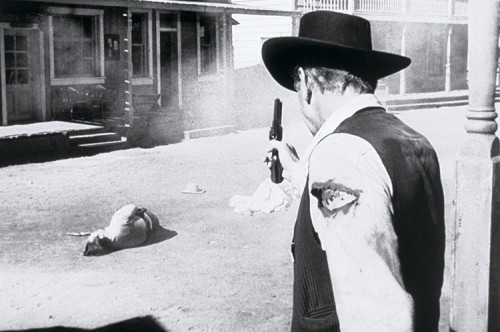






"Young Guns" touches on the "get an edge whenever possible" philosophy of gun fighting with Billy's fight with Texas Joe Grant. In the movie Billy asks to see Grant's gun, as he has boasted he will kill Billy the Kid with it. While looking it over, Billy removes shells from the cylinder so that Grant's first pull of the trigger produces only a "click!". In real life, a drunk Grant had exchanged guns with a cowboy with Billy. Billy, knowing that pistol had been fired and not reloaded earlier in the day, asked to see it and spun the cylinder so that the next three pulls of the trigger would cause the hammer to fall on an empty shell. When Grant subsequently tried to shoot Billy in the back, Billy quickly drew his own pistol and killed Grant.
One last movie that is pretty good as far as authentic feel to a gunfight is "Open Range" with Kevin Costner and Robert Duvall. The end gunfight has problems, like Costner firing way more than six shots from his six-shooter at one point, but the start of the fight is excellent, you can tell the different between pistol, rifle and shotgun shots by their sounds, there are misses, ambushes, horses and bystanders are hit, and men trying to surrender are shot down.
With all of that said, most gunfights that come out of Hollywood are indeed pure invention, but they sure are entertaining!